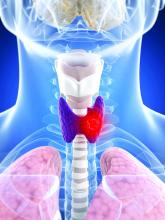After 3 years of follow-up in patients with low-risk differentiated thyroid cancer (DTC), there is no significant difference in the rate of tumor-related events in those treated with postsurgical radioactive iodine (RAI) relative to those who are not, according to a randomized phase 3 trial.
The controversy about whether postoperative RAI is beneficial or an overtreatment in low-risk DTC has persisted for years, but it can now be addressed with level one data, according to Sophie Leboulleux, MD, PhD, who heads the thyroid cancer division at Gustave Roussy Cancer Institute, Villejuif, France.
The trial, called ESTIMABL2, included 776 low-risk DTC patients managed at 35 participating treatment centers in France. Two to five months after surgery, patients were randomized to receive RAI or to follow-up without RAI if there were no suspicious findings, such as changes in lateral neck lymph nodes, on ultrasonography.
Three years after randomization in 729 evaluable patients, tumor-related effects occurred in 4.1% of those randomized to RAI and 4.9% of those randomized to follow-up without RAI.
“Thus, 95.1% of patients in the followed group and 95.9% in the RAI group had no event over 3 years of follow-up. The difference of 0.8% was noninferior by the prespecified definition,” Dr. Leboulleux reported at the annual meeting of the Endocrine Society.
The 0.8% difference in events is noninferior
The prespecified definition was a less than 5% difference in events at the end of 5 years. The 0.8% difference in this study was comfortably within the 95% confidence interval (–3.3%-1.8%).
On yearly evaluations under levothyroxine treatment, events were defined as an indication for treatment, whether surgery or RAI administration if there was abnormal RAI intake on the posttherapeutic whole-body scan or elevated thyroglobulin or thyroglobulin antibodies. In the latter case, this was an event even in the absence of abnormal neck ultrasonography.
“Elevated thyroglobulin levels on levothyroxine treatment were defined as greater than 2 ng/mL in the group that did not received RAI and greater than 1 ng/mL in the group that did,” Dr. Leboulleux reported.
Thyroglobulin antibodies were considered elevated with a greater than 50% increase over the upper limit of normal on two consecutive determinations 6 months apart, Dr. Leboulleux said. The same or similar definitions of an event have been used previously.
Of the study population, 83% were women and almost all (96%) had papillary DTC. The mean age was 52 years. Of the tumors, 81.1% were T1b, of which more than half were unevaluable for node status and about 40% were node negative. The remaining tumors were grade T1a, of which about two-thirds had unevaluable node status and the remainder were confirmed node negative.
Prior studies also question RAI benefit
Several retrospective studies have also failed to associated RAI with a significant protection against thyroid events in low-risk DTC. In the most recent guidelines, the American Thoracic Society recommended against routine use of RAI following surgery in low-risk DTC patients. However, these guidelines acknowledged this is a “weak recommendation” based on “low-quality evidence.”
Recurrence rates following surgery in low-risk DTC are not zero. According to a review article coauthored by Dr. Leboulleux, these may occur in up to 3% of patients. This measurable risk might explain why many published retrospective data suggest low-risk DTC patients are continuing to receive postsurgical RAI. In one, using data taken from the Surveillance, Epidemiology, and End Results (SEER) database, nearly 25% of 17,286 low-risk papillary thyroid cancers had received postsurgical RAI.
The ESTIMABL2 trial is one of two randomized studies launched over the last several years to address the controversy regarding postsurgical RAI in low-risk DTC with prospective randomized data. The ongoing IoN trial is the other. The researchers plan a much longer follow-up, with data not expected until 2031.
In fact, one criticism of the ESTIMABL2 is “the low event rate and relatively short follow-up,” reported Megan Haymart, MD, a professor in the division of metabolism, endocrinology, and diabetes at the University of Michigan, Ann Arbor.
“The strengths of this study include the involvement of 35 French centers, the use of a cohort that is representative of the distribution of low-risk thyroid cancer at large, and the use of biochemical markers during follow-up,” Dr. Haymart said in an interview.
Ultimately, despite the limited follow-up, “this is a clinically important study as it supports the recent paradigm shift towards less use of RAI for low-risk thyroid cancer,” she said.
Dr. Leboulleux and Dr. Haymart report no relevant conflicts of interest.


